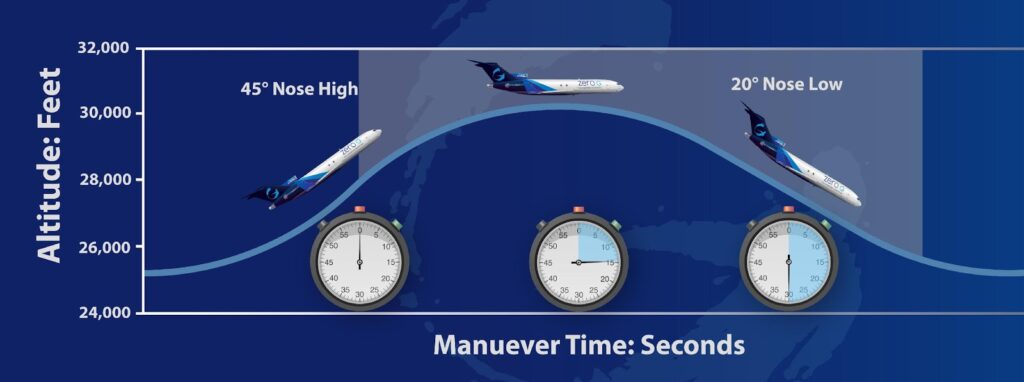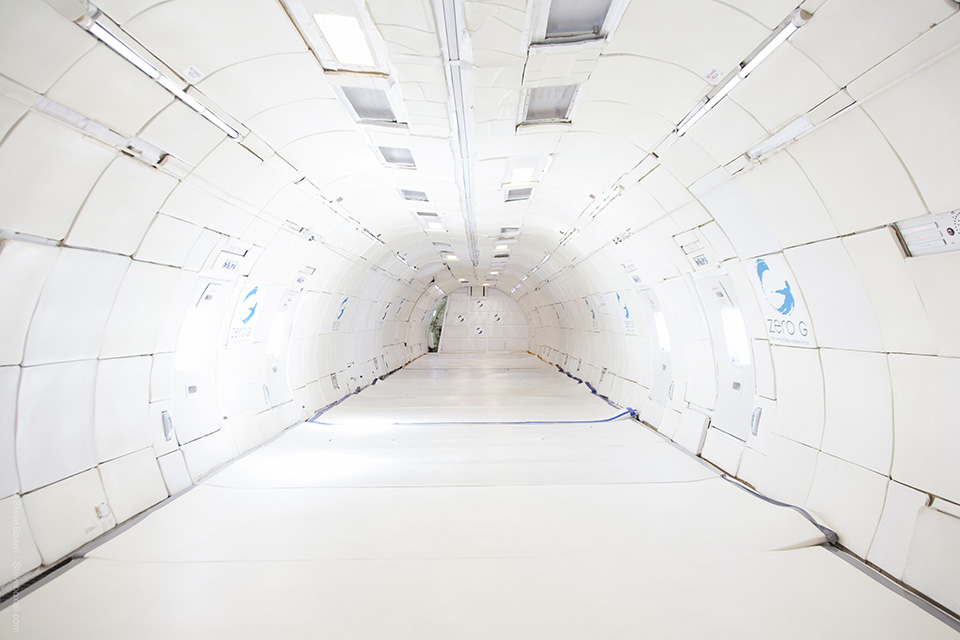
Frequently Asked Questions
About Mission: AstroAccess
Have questions?
Watch our Flight One Informational Webinar!
Is there just one flight?
Nope! Mission: AstroAccess flight one took place on October 17, 2021, but our long term goal is to crew several ZERO-G parabolic flights, move onward to suborbital spaceflights, and eventually place a disabled astronaut into Earth orbit. We have a second parabolic flight confirmed for 2022, and more surprises in store!
No! As of 2022, we are ecstatic to welcome international applicants! However, all applicants must be able to enter the U.S. on your own with a valid passport or visa. We will not be sponsoring any visa applications or letters of recommendation.
What about COVID-19? Do I need to be vaccinated to participate?
The health and safety of our crew is our highest priority. To help prevent the possible spread of disease during the pandemic, ZERO-G is conducting rapid COVID-19 tests of participants before each flight. Even with this measure in place for the flight, we want to keep everyone as safe as possible. We require all participants to be fully vaccinated against COVID-19 prior to participating in any of our activities.
Yes! As with any project that aims to advance disability inclusion, we believe members of the disability community, and their unique perspectives and experiences, must be included in every step of the planning process.
What kind of people are you looking for?
How is this related to SciAccess?
SciAccess is an international organization founded in 2018 in order to promote disability inclusion in STEM. It began as an annual conference and has since expanded into numerous global programs, including Mission: AstroAccess. While Mission: AstroAccess falls under the umbrella of SciAccess programs, it is supported and made possible by a vast network of exceptional partner organizations and nonprofits, featured at the bottom of our Home Page.
About the Flight
Flight 1 took place on October 17, 2021, in Long Beach, CA. Applications are now open for Flight 2, which will take place on November 19, 2022, in Fort Lauderdale, Florida!
The Zero Gravity Corporation's B-727 aircraft (named G FORCE ONE) takes off like any other airplane. G-FORCE ONE flies in FAA-designated airspace blocks approximately 100 miles long and ten miles wide (likely over the Pacific on our flight). The process starts with the aircraft flying level with the horizon at an altitude of 24,000 feet. Participants will move from their seats to padded 'floating area' in the front of the aircraft cabin. Once everyone is ready, the fun begins! The pilots gradually increase the angle of the aircraft to about 45° relative to the horizon until reaching an altitude of 32,000 feet. During this phase, passengers feel the pull of 1.8 Gs. Next, the plane pushes over the top of the parabolic arc and the zero-gravity phase begins. For the next 20-30 seconds, everything in the plane is weightless. Finally, the plane gently pulls out of the maneuver, allowing flyers to gradually return to the floor of the aircraft. The maneuver is typically flown 15 times over the course of the flight, each taking about ten miles of airspace to perform. In addition to zero gravity, flyers aboard G-FORCE ONE experience Lunar gravity (one sixth your weight) and Martian gravity (one third your weight), achieved by flying a wider arc over the top of the parabola. On a typical flight, parabolas are flown in sets of three to five, with short periods of level flight between each set.

Yes! The plane uses standard seatbelts found on commercial aircraft.
If there is a life-threatening emergency, ZERO-G will stop the flight and return to the airport. Otherwise, if you simply become air sick or have other difficulties, trained ZERO-G personnel will be there to help.
It is currently not our plan to allow personal attendants to fly with disabled participants. This may be something we reconsider on subsequent flights. Designated AstroAccess support crew members will be available throughout the plane cabin to assist in demonstrations. Flyers will also be supported by the professional ZERO-G coaches and flight attendees, who are trained to ensure the safety of all flyers.
On an airplane, blind people travel with either a long cane, stowed safely against the fuselage, or a folding cane secured in the seat back pocket ahead of your seat. This is safe and well-established. However, a zero gravity flight is new territory.
Nobody knows how to balance the potential danger of a cane that gets loose during the flight with the essential need for a blind person to have access to safe means of moving about independently during an emergency. That is one of the things we hope to investigate either on this, or subsequent flights. Either way, you will stow your cane securely at the beginning of the flight and retrieve it when the flight is over. You will always know where it is and be able to access it in case of emergency.
Mobility devices can be used on the ground up to the point of boarding the aircraft. We will be working with mobility-limited participants to determine best practices for getting them onto the plane as well as into and out of the 'floating area' in the aircraft.
You are, of course, very welcome to bring a service animal with you when you come to Florida for training and other activities before and after the flight, but just as you would not take a service animal aboard a roller coaster, you cannot bring a service animal aboard the ZERO-G flight.
The cabin noise levels inside the 727 have been measured at 70-90 decibels during parabolas. This correlates to the engines being at low thrust during the low-gravity portions and at high thrust during higher-gravity portions of the flight.
ZERO-G typically uses verbal commands and instructions on the aircraft. Part of our objectives are to find out what other types of signals are needed to ensure everyone can safely participate! At the very least, an assigned assistant will be available to signal those with low hearing.
Yes! In addition to your fellow participants, ZERO-G staff includes experienced Coaches onboard the aircraft to help with your experience.
Does the ZERO-G staff know about disability? Will they be willing to let us do what other participants do on a flight?
We are working closely with ZERO-G, and they understand the need to balance the needs of disabled participants to be independent and the need for coaching for new fliers.
ZERO-G utilizes a converted Boeing 727-200 cargo aircraft (N794AJ). There are 38 first-class airline seats installed in the rear of the aircraft along with safety equipment. The part of the aircraft cabin is an open 'floating area' with padding on the floor, walls, and ceiling. The floating area is approximately 66 ft long by 10 ft wide and 7 ft high.

Will there be someone aboard who knows American Sign Language (ASL)?
What does the High-G portion of the flight feel like?
"G" is the symbol for the force of gravity. 1 G is what you feel all the time, walking around on Earth. If you can imagine doubling your weight, that would be 2 G. For context, when you accelerate in a car, you might feel an extra one third gravity, but you probably have not felt 2 G acceleration in a car unless you are a race car driver. Roller coasters, on the other hand, can push you back into your seat anywhere from 2 to 5 G. The high-G portion of the flight should be 1.8 G at the most.
Martian gravity is about .38 G , meaning you will be about 1/3 of your normal Earth body weight. Objects drop at 3.721 m/s² (vs 9.807 m/s² on Earth!), so you will notice that you fall much slower when you hop or jump.
Lunar gravity is about .166 G , meaning you will be about 1/6 of your normal Earth body weight. Objects drop at 1.62 m/s² (vs 9.807 m/s² on Earth!), so you will notice that you fall much, MUCH slower when you hop or jump.
Zero gravity (or "free fall") is hard to describe! You still have mass and any acceleration you provide by jumping or pushing yourself will remain until you bump into something else. The weightless sensation is unlike anything you've ever experienced previously. It is not like scuba diving or like sky diving (where you can kick or pivot to control your motion)--it is not like anything on Earth!
We expect a time commitment of 5 hours per week between selection and December 2022. Prior to the flight, there will be forms to fill out, research projects to develop, and we will be in touch with you about training. You should set aside four days before the flight for preparations and be ready to travel to Florida to fly. You may also be asked to answer questions from the press, talk and write about yourself and your passion for disability inclusion in space and utilize any social media at your disposal to promote Mission: AstroAccess activities. Our partner organizations may also ask you to work with them in promoting their participation.
And, have a fantastic time and celebrate with us as disabled people draw closer to equality!
The Application Process
Yes. We know this can be a personal subject, but we have 3 reasons for asking you to disclose your disability in detail: First, although the presence of a disability does not make a zero G flight more dangerous per se, there are some situations (such as heart problems) that make the flight unsafe for some people. Second, This is a research flight. We have to know the abilities of our crew so that we can design tasks that will answer real questions about real people in space. Finally, as an AstroAccess Ambassador, you must be comfortable talking about yourself and your disability in public. You absolutely do not need to disclose every aspect of your disability publicly, but you must be comfortable talking about the aspects of your disability that make you a good fit for our project.
The 2022 application deadline has been extended to 11:59 PM ET on June 17, 2022. We anticipate notifying candidates of their preliminary selection, by the end of August. This timeline is subject to change. The flight will take place on November 19, 2022.
We plan on contacting all shortlisted candidates by the end of August 2022.
What will help me most in the application process?
We know it sounds cliche, but be yourself. Don't be afraid to show that you are passionate, joyful, creative, hard working and a superb team player. We want to learn about you, your situation, and the ways in which this opportunity would impact your work. Also... fill out the forms completely, accurately and on time, and be ready to answer questions as they arise. When it comes to your 2 minute video, we are not concerned with its production value or social media impact, but rather its content. We are excited to learn about why you would be an incredible fit for this project!
